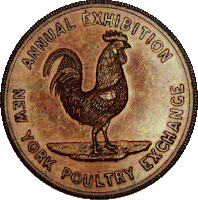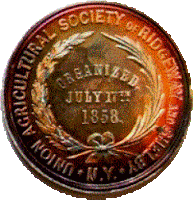MISCELLANEOUS WORKS OF ROBERT LOVETT SR.
Jesse D. Elliot Tribute Medal to James Fenimore Cooper
The story of this medal begins with the Battle of Lake Erie during the War of 1812. It was said that Captain Elliot, commanding the 'Niagra' held back from the battle and let the British concentrate their fire on the 'Lawrence' commanded by Captain Perry. In his volume "The History of the Navy" Cooper refuted this and suggested that Elliot should share in the credit for the American victory. Perry supporters attacked this work in reviews and Cooper sued one of them for libel and won.
In gratitude for
Cooper's defense of him Jesse Elliot commissioned a silver medal struck
to be presented to Cooper. White metal copies were also struck and
distributed to other dignitaries and organizations. Many of these are
found bronzed or silver-plated. I don't know if the silver example
presented to Cooper still exist.
|
Copper (99.11% copper, traces of misc. elements), 51.1mm
Although accounts I have read of this medal
do not record copper examples being struck
xray-fluorescence analysis of this example
shows it to be nearly pure copper.
White metal, 51.1mm
Cast copy, 51mm
FROM COMMODORE JESSE DUNCAN ELLIOTT
City Hotel, New York, Jany. 9, 1845
My Dear Sir
I had hoped the pleasure of a sight of your pretty face at the Tammany
Hall last night, a more dense and crowded hall I have never seen.
My hand has been so much embraced and my arm almost drawn from the
socket that you will not have a very ledgible letter. The Medal has
taken well is in possession of the President of the U. S. the heads of
departments, Expresidents of the U. S. or widow if no widow eldest
child John Q. Adams claimed two and asked me to allow him to hand one
to a nephew and suggested father that I send one to each of the
Philosophical societies of the U. States numbering 12, I wrote him a
note enclosing the medal for his nephew remarking that you would
estimate the compliment more could you know that the presentation came
from the frank of the fathers of the House of Representatives and of
the Senators of our country, they are now on the way one to each of
our Embassadors abroad and to the Ministers representing foreign
courts at Washington, to the Gov" of our states of birth and adoption
to Co1 Polk, Mr. Dallas, Shubrick, Warrington, Strangham, McNeal and a
host of others, when all is done Geo. M. Dallas, cheif justice Gibson
and some other distinguished person will witness the breaking of the
die and their certificate of the fact will be sent you. Thus my dear
Cooper I shall have discharged a debt of gratitude and set an example
of a proper reward for the labor and trials of the Historian. You were
very much wished for here and I regret you did not come down, I am at
Philadelphia as you will have seen and will be glad to take you by
the hand there.
Very truly yours
J D Elliott
I have not seen that scoundrel Mackenzies book, where is it and in what form did it come?
The medal referred to bears on the obverse a
profile of Cooper and around it the legend "The Personification of
Honor, Truth, and Justice"; and on the reverse an oak wreath and the
inscription, "To J. Fenimore Cooper, The Offering of a Grateful Heart
for His Disinterested Vindication of His Brother Sailor, Jesse D.
Elliott."
From "The Correspondence of James Fenimore Cooper"
Yale University Press, 1922 Gouverneur Agricultural and Mechanical Society Ny-295, bronze, 45mm
|
New York Poultry Exchange
Harkness Ny-380, copper, 45mm
(on line image)
I am tentatively attributing this to Robert Sr. as the reverse die
is found in combination with the obverse die for Ny-520
Union Agricultural Society of Ridgeway & Shelby N.Y. Award Medals
(images courtesy of Stacks Archives)
From The
Cultivator, Volume 8, Series 3, 1860: "
We have been shown a new Silver Medal, struck off by Robert Lovett of
New-York, for the Union Agricultural Society of Ridgeway and Shelby. It
is enclosed in a neat case, also prepared by Mr. L., of an appropriate
and tasteful design. The Society is entitled to much credit for
providing this very appropriate testimonial for its exhibitors, and it
can scarcely fail to increase their numbers."
|
Harkness Ny-520, bronze, 44.7mm
(image from Yale University Art Gallery)
Harkness Ny-520, silvered white metal, 44.6mm
Harkness Ny-520, silvered white metal, 44.6mm
Generic Award Medal?, obverse of Harkness NY-520, white metal, 44.8mm.
|
|
|
since he was in the habit of producing such works and his father
was not.
Small size, second reverse, Washington obverse
GW-350, Baker 340, Harkness Ny-522, silver, 28.6mm
|
|
|
GW-350, Baker 340A, Harkness Ny-522, white metal, 28.6mm
IMAGE NEEDED
Although very similar to the first reverse this reverse has some
differences - "SOCIETY" being abbreviated as "SOC:", a
different wreath, and the inscription within the wreath not the same.
The obverse die appears to be the same die as the obverse as Baker 373
but missing the small symbol beneath the bust; the reverse of
this medal was the work of George H. Lovett. A note in Baker
indicates this die appears to be the work of C.C. Wright. Although the
quote from The Cultivator above attributes the medal to Robert Sr. can
we assume both are his products?
1852 Calendar Medal
White metal, 39.6mm
1849 Odd Fellows Hall Dedication Medal
Type 1, white metal, 38mm
Type 2, white metal, 38mm
First Presbyterian Church Communion token
Pewter?, 28mm
The original tokens for this
congregation were hand engraved, silver pieces dated 1800. These die
struck examples were for the black members of the congregation and
although dated 1800 it must have be done sometime after 1816. Although
not easily visible in the images at 6 o'clock on the reverse the
signature "LOVETT NY" is found. For more information on this token see
Tony Chibarro's article at
http://www.angelfire.com/sc2/tokenofthemonth/token017/ Original silver Communion token
|
Washington Passing the Delaware
Embossed monochrome cameo, 10 1/4" by 6 1/4"
| This print is after Thomas Sully's painting of an iconic moment in American history. Entitled "The Passage of the Delaware" it depicts George Washington the moment before he dismounts and begins his crossing of the Delaware River. The title below the image reads "Washington Passing the Delaware" and in the lower right hand corner is "R Lovett". |
Silver Engraved Spoon
|
|
|
Wax Seal Impression in Presentation Box
Wax impression 33 x 35.8mm, wood box 49.7mm
|
|
|
This appears to be a wax impression of a seal that had been engraved by
Robert Lovett Sr. There is a similar item in the collection of the New York
Historical Society (https://www.nyhistory.org/exhibit/seal-impression-box-15).
Was the original seal kept in this box at one time and now just this wax
impression or was this impression made by Robert Sr. and sent to the
recipient for their approval? The motto "Pacis Nuncia" and the dove with olive branch
atop the shield is associated with the Murray family of Stanhope, Scotland.
(from "A General and Heraldic Dictionary of the Peerage and Baronetage
of The British Empire", by John Burke, Esq., 1832)








































